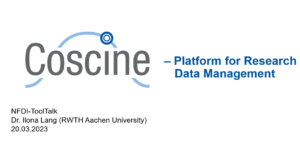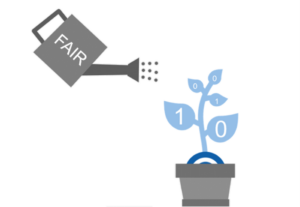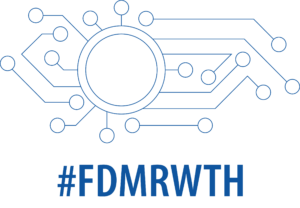On March 20, 2023, Coscine was presented as part of the NFDI ToolTalk series. As previously announced in the NFDI Talks blog post, here is the post-event report on the digital event. What the contents of the presentation were, we have summarized for you in this post.
The NFDI hosts regular Talks in which experts from various disciplines present exciting topics in research data management (RDM). The current ToolTalk focused on Coscine.
What is the motivation behind Coscine?
Coscine offers many good reasons to use it. To understand the motivation behind its use as well as development, two sides need to be illuminated. When users are asked about their motivators for using Coscine, they often cite three factors:
- The need for storage (e.g., RDS.NRW),
- the need to meet funding requirements
- and the obligation to archive research data for a period of 10 years.
From the perspective of the university and the NFDI, the main reason for developing Coscine is to meet the requirements for the RDM, especially with regard to the management of metadata. Examples of such requirements are the requirements of the NRW Higher Education Act to ensure good scientific practice (NRW HG § 3 para. 1).
Researchers often have difficulties in taking FAIR principles into account when dealing with research data. In most cases, only the data of a project that play a role in publication are treated accordingly FAIR. This leads to valuable (metadata) information being lost. To help researchers implement FAIR principles when handling research data, we have developed Coscine as a solution. This provides a data storage and linking environment that automatically implements FAIR principles for any data source.
Coscine offers different resource types. Among them are three RDS variants such as RDS-Web, RDS-WORM and RDS-S3. Other resource types include Linked Data and GitLab, which can be used to link externally stored research data and code.
How does Coscine work exactly?
In addition to the presentation of Coscine, the ToolTalk also included a demonstration. Participants were thus guided step by step through the platform for RDM. Did you miss the demonstration? The entire talk was recorded and can be viewed on YouTube. The Coscine demonstration starts at minute 10:10 and ends at 23:05.
[Das Video wird nach dem Klick von Youtube geladen und abgespielt, dazu baut der Browser eine direkte Verbindung zu den YouTube-Servern auf. Es gilt die Datenschutzerklärung von Google.]
Sow simple data and reap FAIR data
We have already addressed the extent to which FAIR principles are adhered to with Coscine in a blog post.
Here are the key data:
- Research data can be made findable with the help of metadata, the application profile generator AIMS, PID, and RDS resources.
- The login via SSO or ORCID, the PID and the RDS resources contribute to the accessibility of the data.
- Interoperability is ensured by the metadata and the application profile generator AIMS.
- The research data becomes reusable thanks to the login, the metadata and the resource types.
FAIR Digital Objects
Which RDM standards are used in the background? The use of FAIR Digital Objects is intended to create a standardized and interoperable method for describing, storing and exchanging digital objects. This method creates easier use and reuse of digital objects across different systems. Semantic Interoperability enables communication and interaction between different systems through the use of common, standardized W3C data types. In this context, access control is enabled through the use of JSON Web Tokens (JWT). The Data Catalog Vocabulary (DCAT) is used to store and deliver Linked Data (RDF), which defines the hierarchy of catalogs, projects and resources, and datasets. Linked Data discovery is accomplished through the use of the Linked Data Platform (LDP), which enables hierarchical search and exploration. The relationship between data and metadata is defined using FAIR Data Points. Domain-specific metadata is validated with SHACL application profiles to ensure that it meets established standards and requirements.
Long Term Interoperability (LTI) describes the ability of systems to interact and communicate with each other over the long term. An important part of this is the use of Typed PID Records, which serve as unique identifiers for digital objects. A recent development in this area is the Coscine Kernel Information Record, which is currently being defined. It comprises a small set of generic metadata and is used to provide access to the object as well as its properties. Defined types of access interfaces ensure that access to the object and its information proceeds in a normalized manner. The Typed PID Record enables linking with the associated data and (extensive) metadata. These links allow the information about the digital object to be preserved over long periods of time and still remain easily accessible and usable.
An important aspect of data management is interoperability with other tools and systems. This is achieved by developing a central metadata hub such as the NFDI4Ing. By using FAIR Digital Objects and the metadata hub, national and international data management tools, such as the NFDI, EOSC, and Gaia-X, can be interconnected. This prevents data from being stored in isolated silos and makes data reuse difficult. The metadata hub enables the standardized description and linking of data objects and their metadata. This makes it easier to reuse data and make it accessible for future research purposes. Interoperability and data exchange between different tools and systems is thus simplified and improved.
Conclusion
After the NFDI ToolTalk, many questions from the participants were clarified. In turn, the Coscine team took on board a lot of feedback and further suggestions for the platform. For this productive exchange, we would like to express our sincere thanks to all participants as well as to the NFDI, which made the talk possible.
If you don’t want to miss any more Coscine events, you can find out about all upcoming as well as past events on the website.
Learn more
Don’t want to miss any more news about Coscine? Then subscribe to our mailing list and visit us on our website.
Do you have any questions or feedback? Then send a message to the IT-ServiceDesk. We are looking forward to your message!
______
Responsible for the content of this article is Arlinda Ujkani.







Leave a Reply
You must be logged in to post a comment.